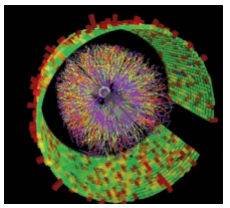NERSC Helps STAR Researchers Find Evidence of Elusive Phenomena in Mountains of Experimental Data
June 1, 2008
With help from NERSC’s Parallel Distributed Systems Facility (PDSF) and High Performance Storage System (HPSS), the STAR collaboration is analyzing evidence for some of the most elusive phenomena in high energy physics — quarks, gluons, and proton spin.
The STAR collaboration, 600 scientists from 52 institutions in 12 countries, studies the QCD phase diagram of nuclear matter and the origins of proton spin at the Relativistic Heavy Ion Collider (RHIC) at Brookhaven National Laboratory (BNL).
In collisions of highly energetic gold nuclei, hot and dense matter is created that is observed with the Solenoid Tracker at RHIC (STAR), an advanced particle detector. Scientists scrutinize the data from millions of collisions to look for evidence of a new state of matter, the Quark Gluon Plasma (QGP). In a QGP, protons and neutrons are “melted” into a liquid of quarks and gluons. Such a state is believed to have existed in the early universe.
Scientists also study highly energetic collisions of polarized protons in search of the origin of proton spin, a fundamental property resembling internal rotation. The proton consists of quarks and gluons, and hence its spin is carried by quarks and gluons. Recent STAR results refute the view that the contribution from gluon spins compensates for the puzzlingly small sum of quark spins, observed in earlier experiments. The measurements will thus continue to challenge our understanding of the proton, one of the building blocks of nature.
In their research, STAR scientists process hundreds of terabytes of data. With technological advances in the accelerator and detector systems increasing the data rates, their need for large-scale computing resources is increasing every year. In concert with the computing resources available at RHIC, NERSC’s PDSF and HPSS address this need.
HPSS, a massive tape robot system and front-end disk cache, allows the researchers to access the half a petabyte of STAR data and simulations reliably and efficiently. Concurrent and continual access to the data is essential to timely analyses of and comparisons between data sets. HPSS reliably provides such access, even across a data sample of this magnitude. The STAR data analysis at NERSC is accomplished on PDSF, a facility that seeks to exploit the economy of scale in computing to process the data from many STAR collision events simultaneously.
Software tools developed by DOE’s SciDAC project called the Particle Physics Data Grid, a member of the Open Science Grid, have enabled STAR researchers to efficiently transfer the many terabytes of data between the RHIC and NERSC computing sites, as well as to coordinate simulation studies between the main facilities and other satellite clusters. NERSC has been a vital part of the development of the software tools necessary for this effort.
Last year, simulations carried out at PDSF were used as the basis of standard corrections for analyses throughout STAR’s scientific program. Such simulation studies focus primarily on providing a detailed understanding of the detector by embedding a few simulated particles into real data from the experiment. Reconstruction of this data provides an understanding of the performance of the detector and software systems. Also, pure simulation studies of new detector technologies and proposed implementations play a key role in planning the future development of the experiment as a whole.
STAR scientists will continue to acquire new data sets of ever increasing size and complexity. The production of extremely rare particles containing very heavy quarks will be of particular interest for future studies. Massive hadrons are unique probes that will give new insights in the characteristics of the hot and dense matter formed at RHIC.
To date STAR scientists have published over 110 papers in peer-reviewed journals, and presented more than 250 conference talks. More than 100 Ph.D. and Master’s students have written their theses on STAR data. Learn more about the STAR experiment research program at Brookhaven National Lab.
About NERSC and Berkeley Lab
The National Energy Research Scientific Computing Center (NERSC) is a U.S. Department of Energy Office of Science User Facility that serves as the primary high performance computing center for scientific research sponsored by the Office of Science. Located at Lawrence Berkeley National Laboratory, NERSC serves almost 10,000 scientists at national laboratories and universities researching a wide range of problems in climate, fusion energy, materials science, physics, chemistry, computational biology, and other disciplines. Berkeley Lab is a DOE national laboratory located in Berkeley, California. It conducts unclassified scientific research and is managed by the University of California for the U.S. Department of Energy. »Learn more about computing sciences at Berkeley Lab.








